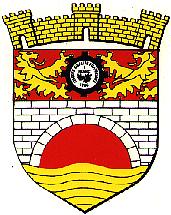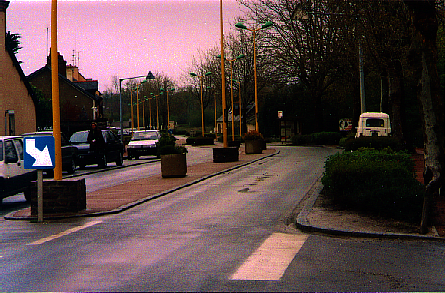


Click here for the latest twinning news

Bagenalstown, County Carlow and Pont Pean, France, will be officially twinned by the middle of the year 2000. A twinning ceremony took place in Bagenalstown in April 1999, with the second leg of the ceremony due to take place in Pont Pean in the Spring 2000.
Members of the Bagenalstown Twinning Committee visited Pont Pean in April 1988 to find out about the town, its people, and its attractions. I travelled with the group. What follows are my impressions of Pont Pean.
Click on the icon opposite to visit the homepage of the Pont Pean Twinning Committee.

Pont Pean is similar to Bagenalstown in many ways. It has a population of 2,600 from its last official count although it is thought that that number may now have increased to over 3,000. Over 30% of its population is under 19.
It has no major crime except for some minor thefts and incidents of vandalism. Its biggest problem is graffiti on walls and buildings.
Unemployment stands at 15% in Pont Pean but the Mayors Office offers job seekers a C.V. creation service and advice on jobs opportunities and related matters. The unemployed receive social welfare, as in Ireland, and there is strong competition for the location of new industries to the area. The town enjoys just a passing tourist trade as there are no major attractions in the area.
Its young population is well served with a multi-purpose sports hall, where local youths play a range of sports including basketball and volleyball. Another room serves for meetings and community functions, while a number of tennis courts are
also to be seen. Below is a picture of the town crest.

The cleanliness of Pont Pean would he the envy of many Irish towns. No litter is visible on the streets or public areas. Household rubbish is collected once a week. The postman calls six days a week and most houses have their letter-boxes in their front garden at waist level height.
Pont Pean has just two schools - a primary and nursery. For further education students must travel to Rennes, a ten minute trip with a regular bus service. The English language is thought to students at a very young age with the language being introduced slowly into the games the children play. Many of the students in Pont Pean have a better grasp of the language than their parents, but their parents are eager to learn. Its nursery school has 133 children in five classes while the primary school educates 185 children in seven classes.
Drivers are very courteous. All cars are left hand drive and driving is on the right hand side of the road. They stop to let other drivers into lanes ahead of them and observe the speed limits which are very similar to Ireland - about thirty miles an hour in town centres, about fifty five on the open road, seventy on dual carriageways and up to eighty on motorways, depending on their grade.
There are no potholes, except on a few lanes leading to houses. All vehicles last much longer as there is little wear and tear due to the excellent quality road surface. Pedestrian crossings and traffic lights are very common with the traffic lights also supporting a second set of lights at dashboard level.

A line of bricks and in some cases grass verges line the centre of the streets to keep motorists on their own side of the road. Mini roundabouts are very common, linking streets from housing estates to the main road.
All types and styles of houses are visible but most are dormer bungalows. The use of wood is very evident in the house designs and all have shutters on their windows - to keep out the burglars and the heat. Most French people prefer to sleep in totally dark rooms and the shutters provide this facility.
AN old lead and silver mine is one of the towns attractions, although most of it is sealed underground by a concrete slab. All that is visible is the water tower and some old ground level buildings, which are presenfly being made safe. It is hoped that after dangerous loose bricks are removed funds can be found to create a museum on the site.
The first records of the mine date back to 1628. At its peak in 1896 it employed 1,000 miners and was one of the most important non ferrous metal mines in Europe. It closed in 1930.
But for the real story of the old mine, visitors should not miss the Miners Church which stands adjacent to the buildings. The story of mining is told by a serious of etchings which adorn a full wall of the Church, only interrupted by two statues. Miners would come to the Church for mass and their mining gear would hang from ropes from the ceiling. The Church is still in use and on one of its walls hangs pictures of recently baptised children.
Meal time in France is totally different than in Ireland. A typical meal can last several hours as the French feel it is important to fmd time for talking with members of their family. A starter might consist of a salad dish, followed by the main course which
could feature chicken, beef or veal. A selection of cheeses will definitely he served, most of which will be white.
Deserts are excellent with an enormous selection available. They range from apple pie and sweet pancakes, to creations like Ile Flotante (floating island) made from eggs and cream. Tea and coffee follows. The coffee is expresso and served in tiny cups while for tea many varieties are served, several with strange fruity flavours.
Typical family meals consist of breakfast which might be bread, orange juice, cornflakes, and hot milk or coffee. A midday meal might be a starter, main course and cheese while the main meal is in the evening and can take up to four hours. Children would not usually be allowed to drink coffee.
Bread is served with everything and butter is seldom used. Wine is served with everything and red is preferred. Beer and spirits are uncommon unless you visit a bar, but French people prefer to entertain at home and seldom visit bars.
A small shopping centre provides residents of Pont Pean with a selection of services but many prefer to go to nearby Rennes. The shopping centre has a small supermarket, a hairdresser, confectionary shop and a butcher amongst others.
THE main industry in the town is a steel factory which employs thirty. Most people work in Rennes and commute daily. A Citroen factory in nearby Chartres de Bretagne provides many residents of Pont Pean with employment and the area taken up by the factory would easily match that of many small Irish villages.
The Town Hall is the centre for many official functions, including weddings and the meetings of the Town Council. It also incorporates the Mayors Office and its clerical and administrative staff.
A budget of about £1 million is spent on the town each year. Most of this comes from local taxes, with housholders paying
property tax.
To get to Pont Pean the most direct route is to fly to Rennes but flights are only available from May onwards. At other times flights to Beauvais Airport will be followed by a five hour road journey, while a flight to Paris will be followed by a three and a half hour coach trip. The Ferry Port at Roscoff is 200 kilometres from Pont Pean.
Copyright(c)Jarlath Judge 1998
Irish Stamps |
County Carlow News |
Links |
Find Your Birthday |
Pop Quiz |
Gemma's Beauty Page |
About County Carlow |
Free Web Counters |
Awards |
E-mail your news to us |
Free News Tickers |
Guestbook |